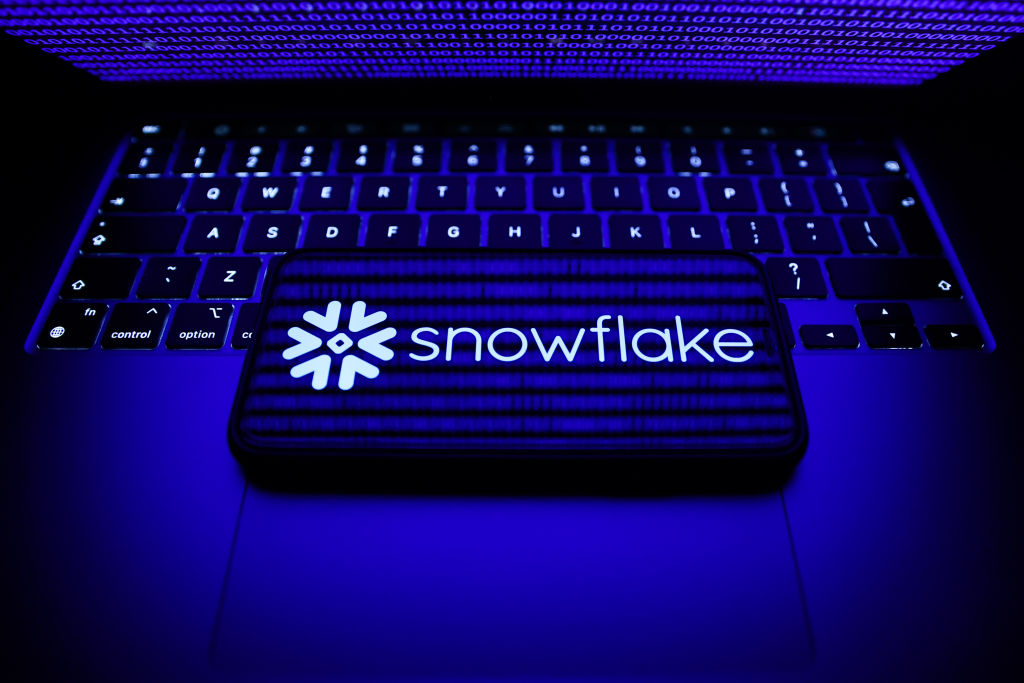Snowflake Stock Rallies on Rising Revenue
Snowflake stock is surging Thursday after the cloud company beat fourth-quarter expectations, issued strong guidance and expanded a partnership with Microsoft.


Snowflake (SNOW) stock is surging Thursday after the cloud company beat top- and bottom-line expectations for its fiscal 2025 fourth quarter, issued a better-than-expected revenue forecast for 2026 and announced an expanded partnership with Microsoft (MSFT).
In the three months ending January 31, Snowflake's revenue increased 27.4% year over year to $986.8 million, boosted by product revenue growth of 27.8% to $943.3 million. Earnings per share (EPS) declined 14.3% from the year-ago period to 30 cents.
"We delivered another strong quarter, with product revenue of $943 million, up a strong 28% year-over-year, and remaining performance obligations totaling $6.9 billion," said Snowflake CEO Sridhar Ramaswamy. "Today, Snowflake is the most consequential data and AI company in the world. More than 11,000 customers are already betting their business on our easy-to-use, efficient, and trusted platform."

Sign up for Kiplinger’s Free E-Newsletters
Profit and prosper with the best of expert advice on investing, taxes, retirement, personal finance and more - straight to your e-mail.
Profit and prosper with the best of expert advice - straight to your e-mail.
The results topped analysts' expectations. Wall Street was anticipating revenue of $956.2 million and earnings of 17 cents per share, according to Investing.com.
For 2026, Snowflake said it expects to achieve product revenue of approximately $4.28 billion, representing growth of 24% from fiscal 2025 and ahead of analysts' expectations of $4.23 billion. For its first quarter, Snowflake anticipates product revenue in the range of $955 million to $960 million, implying growth of 21% to 22% from the year-ago period.
In a separate press release, Snowflake announced an expanded partnership with Microsoft that will "empower enterprises to build easy, efficient, and trusted AI-powered apps and data agents with OpenAI's models directly in Snowflake Cortex AI."
"There's enormous power in our customers being able to use OpenAI models directly in Snowflake's secure platform, unlocking multimodal, agentic, and conversational AI use cases that drive high impact," said Snowflake EVP of Product Christian Kleinerman.
Is Snowflake stock a buy, sell or hold?
Snowflake is down 28% over the trailing 12 months vs a gain of 19% for the S&P 500. But Wall Street is bullish on the tech stock.
According to S&P Global Market Intelligence, the consensus analyst target price for SNOW stock is $204.33, representing implied upside of about 11% to current levels. Meanwhile, the consensus recommendation is a Buy.
Financial services firm Oppenheimer maintained its Outperform rating (equivalent to a Buy) and raised its price target on the AI stock to $220 from $200 following the earnings release.
"Net, we're positive on the strong consumption trends, improving sales/GTM execution, and platform diversification, which highlight Snowflake's increasingly strategic relationship with customers," writes Oppenheimer analyst Ittai Kidron. "We're bullish," the analyst states, "and continue to view Snowflake as a top pick."
Kidron expects momentum from a strong fourth quarter to continue in fiscal 2026, "with room for upside to guidance" in the second half "as the portfolio expands."
Related Content
Get Kiplinger Today newsletter — free
Profit and prosper with the best of Kiplinger's advice on investing, taxes, retirement, personal finance and much more. Delivered daily. Enter your email in the box and click Sign Me Up.

Joey Solitro is a freelance financial journalist at Kiplinger with more than a decade of experience. A longtime equity analyst, Joey has covered a range of industries for media outlets including The Motley Fool, Seeking Alpha, Market Realist, and TipRanks. Joey holds a bachelor's degree in business administration.
-
 The Economic Impact of the US-China Trade War
The Economic Impact of the US-China Trade WarThe Letter The US-China trade war will impact US consumers and business. The decoupling process could be messy.
By David Payne
-
 Retire in Malta for Quiet Coastal Perfection
Retire in Malta for Quiet Coastal PerfectionSeemingly remote yet easily accessible to other points in Europe, sunny Malta offers paths to citizenship and residency for families and retirees.
By Drew Limsky
-
 My First $1 Million: Literacy Interventionist, 59, Colorado
My First $1 Million: Literacy Interventionist, 59, ColoradoEver wonder how someone who's made a million dollars or more did it? Kiplinger's new My First $1 Million series uncovers the answers.
By Joyce Lamb
-
 Will My Children Inherit Too Much?
Will My Children Inherit Too Much?If you worry about how your children will handle an inheritance, you're not alone. Luckily, you have options — from lifetime gifting to trusts — that can help.
By Mallon FitzPatrick, CFP®, AEP®, CLU®
-
 Charitable Giving Lessons From Netflix's 'Apple Cider Vinegar'
Charitable Giving Lessons From Netflix's 'Apple Cider Vinegar'Charity fraud is rife, and a Netflix series provides a timely warning about donating money to a good cause without looking into its background.
By Peter J. Klein, CFA®, CAP®, CSRIC®, CRPS®
-
 What Happens To Mortgage and Savings Rates If Trump Fires Jerome Powell?
What Happens To Mortgage and Savings Rates If Trump Fires Jerome Powell?President Donald Trump expressed his desire to remove Fed Chair Jerome Powell. If the president is successful, how would it impact your savings accounts?
By Sean Jackson
-
 Why You Need a Trusted Contact for Your Brokerage
Why You Need a Trusted Contact for Your BrokerageYour brokerage or bank needs someone to reach out to if it's concerned you're experiencing fraud or cognitive decline. That's where a trusted contact can help.
By John Waggoner
-
 Four Takeaways From Filing Your Taxes to Boost Your Financial Future
Four Takeaways From Filing Your Taxes to Boost Your Financial FutureNow that another tax season is in the rearview mirror for most of us, what lessons can you take from what you learned about your finances to plan for the future?
By Kate Winget
-
 What Claims Adjusters Are Thinking vs What They're Saying
What Claims Adjusters Are Thinking vs What They're SayingAfter a natural disaster, few of us are at our best, but here's what to keep in mind when you're interacting with your insurance company's claims adjuster.
By Karl Susman, CPCU, LUTCF, CIC, CSFP, CFS, CPIA, AAI-M, PLCS
-
 Looking to Make a Job Change? How to Stand Out Like a Pro
Looking to Make a Job Change? How to Stand Out Like a ProTo make a strong first impression in interviews or when networking, skip your job title and work history and use an opening gambit that highlights your talents.
By Anne deBruin Sample, CEO